Medical Alert Review 2025
Simple to set up and use, Medical Alert is a great choice for first-time buyers.

At NCOA, we take the time to research, test, and recommend products that aim to help you live a healthier life. We’ve spent more than 3,000 hours researching medical alert systems to give you the most accurate product reviews. To find the best medical alert systems, we:
- Consulted with doctors and licensed adult caregivers who specialize in working with older adults
- Put more than 35 devices through a series of 16 different tests at our in-house lab
- Mystery shopped more than 15 brands
- Surveyed more than 1,000 medical alert system users and caregivers
- Interviewed experts on older adults falls risk
- Worked with older adults to test medical alert systems and get their opinion
- Read thousands of verified customer reviews
We’re constantly testing new medical alert systems to give you the most accurate and up-to-date recommendations. Read more about our medical alert system review methodology.
- Medical Alert is a beginner-friendly option with a simple setup.
- Models range from $27.95–$47.95 per month, with some equipment and activation fees.
- Medical Alert’s monitoring center staff is EMT/EMD certified, which is unique to this brand.
- The mobile models may not be discrete enough for some.
Medical Alert is a beginner-friendly medical alert system brand that offers straightforward setup instructions and simple-to-use devices. Its quick-start guide and clearly labeled packaging gained this company a 5/5 from our testers, earning it Easiest Setup in our guide to best medical alert systems. Available as a home, mobile, or smartwatch device, Medical Alert is a great choice for people who are new to owning and using a medical alert system.
In this Medical Alert review, we’ll explain the differences between the three models, what features you should consider when purchasing a medical alert system, and what our testers thought about their experience with Medical Alert.
Medical Alert

- Simple to set up and use
- Monitoring center staff are EMTs
- No hidden fees
Why we recommend Medical Alert
We recommend Medical Alert because its simple setup process, clear instructions, and user-friendly devices make it an excellent choice for someone who is new to using a medical alert system. Our testers gave Medical Alert a 5/5 score for its simple setup.
A simple, no-frills system can be great for people who aren’t comfortable with technology or just don’t want to deal with all the bells and whistles that can come with high-tech systems. For older adults who want to maintain their independence, but might be at risk of a fall or sudden medical crisis, medical alert systems can increase their sense of security and provide emergency help as soon as it’s needed.1
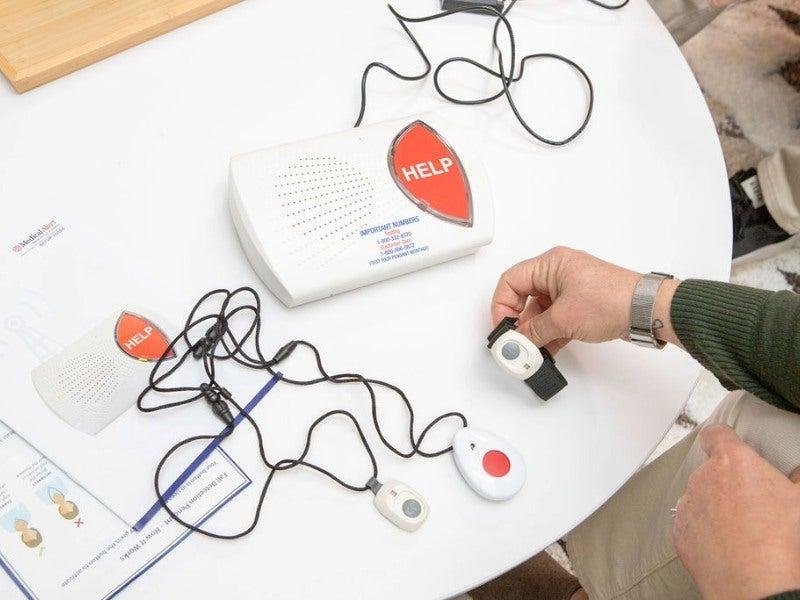
We like that Medical Alert has:
- A monitoring center staff that’s EMT/EMD certified
- Three different options (home, mobile, or smartwatch) to fit every lifestyle
- Clear and simple setup instructions
- A 30-second average response time
- Accurate GPS tracking down to the address
Table 1 Comparing Medical Alert devices
| Comparison Features | |||
|---|---|---|---|
| Max. battery life | 30 hours |
5 days |
48 hours |
| Fall detection | Yes |
Yes |
Yes |
| GPS tracking | No |
Yes |
Yes |
| Standout feature | Landline or LTE option |
Mobile system with GPS tracking |
Smartwatch with touch screen |
Our Medical Alert video review
Want to know more about Medical Alert? This video discusses the brand's range of devices, benefits, and drawbacks. Remember that details like pricing can change over time, and our team is constantly testing new models. So what you see in this article may differ slightly from what we've reviewed on video.
Medical Alert pros and cons
Medical Alert’s clearly labeled packaging helped our testers set up their devices right out of the box. We like that the manual has visual cues, which is helpful both for people who find it difficult to read small-print text and those who simply like a visual aid when understanding directions. The devices themselves are simple with large buttons and bold, easier-to-read print.
We also like that Medical Alert’s response center staff are EMT/EMD certified, which is unusual in this industry. These medically trained monitoring center staffers can better understand health concerns you may have, and give you clear directions on next steps. That could mean sending emergency help or directing you to stay on the line while they better assess the situation.

We don’t like that Medical Alert’s devices include a one-time device fee when some companies like MobileHelp don’t charge you for their equipment. Our testers also noted that you can’t cancel a call once the button was pressed, though we have noticed this issue across many brands.
Pros
- Earned Easiest Setup in our Best Medical Alert Systems review
- User-friendly, simple design
- Clear and strong two-way communication
- Medically trained monitoring center staff
Cons
- Short battery life
- Bulky to wear
- One-time equipment fee
- No call cancellation option
Medical Alert device reviews
Home System
Medical Alert’s home system is a beginner-friendly choice for people new to owning a medical alert system who mostly stay close to home. It comes in both a landline and cellular option and offers strong, two-way communication with EMT/EMD certified monitoring center staff. The landline option is the most affordable device from Medical Alert.
Home System
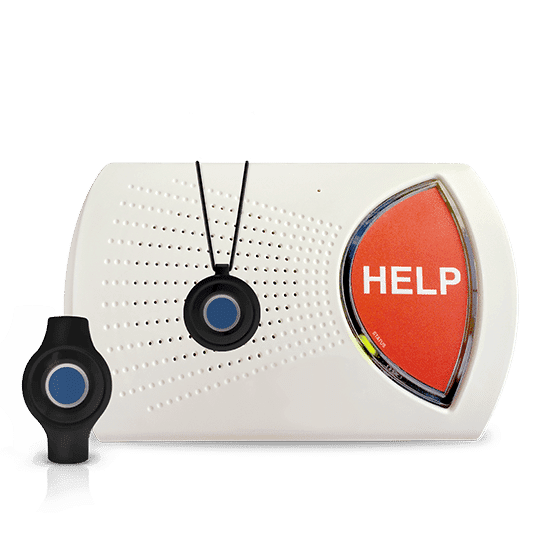
- No need to charge the battery, since it plugs into the wall
- Covers area up to 800 feet (two and a half football fields)
- Waterproof button for bath and shower use
- Device type: At-home
- Fall detection: Yes
- Max. battery life: N/A
- GPS tracking: No
- Caregiver alerts: Yes
- Connection type: Landline or LTE
What’s different about the Home System
The Medical Alert Home System connects to either a landline or cellular network. The landline option is the most affordable at $27.95 per month, while the cellular option costs $37.95 per month. Both choices include a $99.95 one-time programming fee.
The landline and cellular options share some features, including:
- A coverage range of 800 feet, which is about the length of two and a half football fields
- A backup battery life of 30 hours in case of a power outage
- Interchangeable wristband and necklace options for the help button
- Waterproof help button for shower and tub use
- Includes an in-home communicator, help button, and user manual
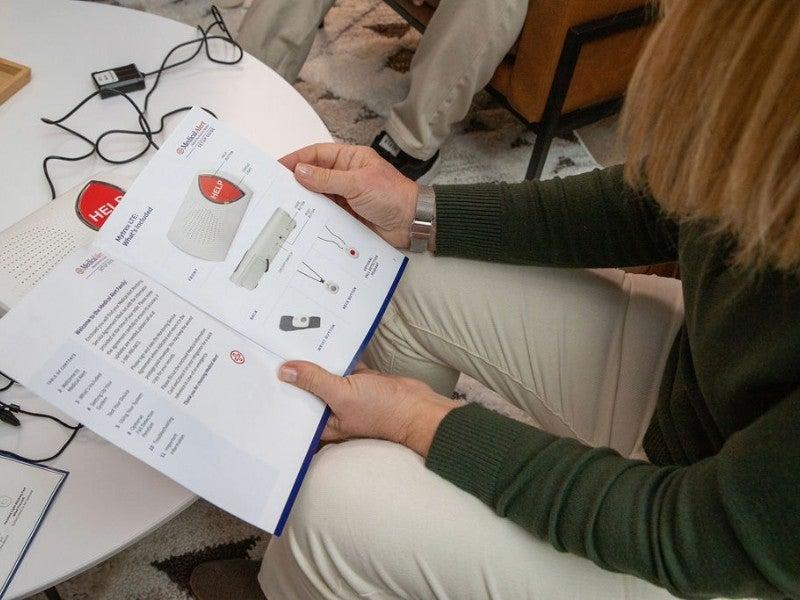
The biggest differences between the landline and cellular options are the price and connection source. The cellular model is about $10 more per month and uses AT&T for service instead of plugging into a landline connection. You don’t need to have a cellular plan or phone to use this model, but you should double-check AT&T’s coverage map to make sure your area has strong coverage. If you live somewhere more rural with limited cellular coverage, you’d want to choose the landline option.
Our testers liked that the Home System made it a breeze to install the device. One tester said, “Clear and easy setup. I don't think most users would have any issues getting started with their devices.”
Once installed, the testers placed a call to the monitoring center. They found communication to be clear, loud, and strong. “It was easy to press the button and it immediately began connecting to the monitoring center,” one tester said. “I liked that you didn't need to press very hard or hold it down for a certain amount of time.”
One drawback we found is that the wristband is hard to move from one size hole to another. This can become an issue for people with arthritis or other dexterity issues. Our testers also weren’t impressed by how clunky and medical-looking the fall detection button was.
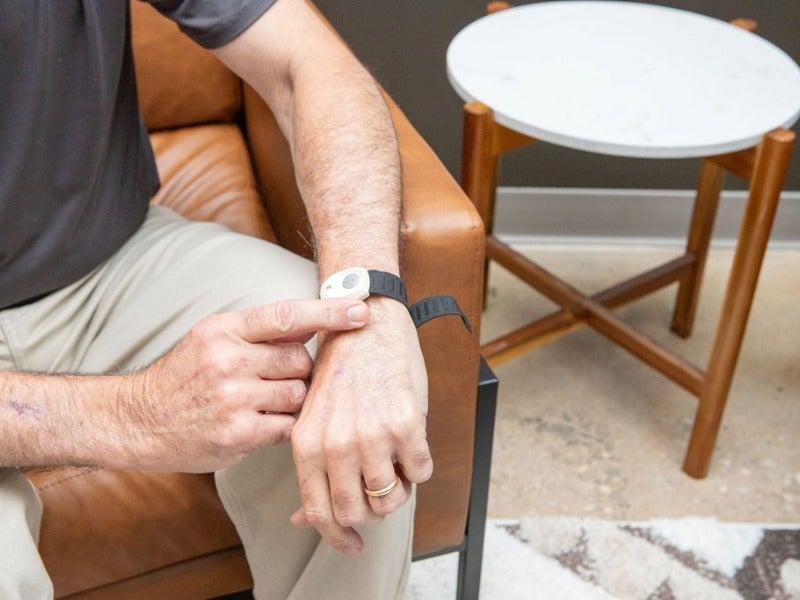
The wearable buttons for the home are small and relatively discreet [but] the fall detection wearable is much bigger and bulkier. It is not something you could pass off as jewelry,” one tester said.
Mobile System
The Medical Alert Mobile System is a mobile device you can wear as a necklace or on a belt clip, both at home and while you’re out. With two-way communication through the device and accurate GPS tracking, the Mobile System is a great choice for someone who spends lots of time outside the home.
Mobile System

- Comes in both a standard and mini option
- Accurate GPS tracking down to the address
- Lightweight and waterproof
- Device type: GPS
- Fall detection: Yes
- Max. battery life: 5 days
- GPS tracking: Yes
- Caregiver alerts: Yes
- Connection type: LTE
What’s different about the Mobile System
The Medical Alert Mobile System connects you to a 24/7/365 response center wherever there is cellular coverage. It lets you speak to the monitoring center staff from the device itself instead of through a base, like the Home System. It comes in two sizes: the standard and the mini. The standard can be worn on a necklace or in a belt clip, and the mini can be worn on a necklace or as a bracelet. Both sizes offer two-way communication when you press the button and GPS tracking, so help can find you no matter where you might need it.
One drawback is that the standard size Mobile System isn’t very attractive. Several testers said they thought the device was “bulky” and “ugly,” with one tester saying “I don't find it particularly sleek or discreet—though it's lightweight.” This is definitely something to consider. Research has shown that older adults are less likely to wear a device that makes them feel old or frail.2

Like the Home System, our testers found setup to be straightforward and intuitive. One plus of the Mobile System is that the charging cradle verbally announces when the device is charging. This is a nice addition that provides reassurance to a user that they’ve successfully connected their device, especially those with vision or dexterity issues.
And when our testers tried to make a call, they found the process to be clear and simple. “It's easy to press the button and connect to the monitoring center. It made it clear it was calling for help,” one tester said. They thought the audio quality was good and the network connection was strong. Several noted the friendliness of the response center staff and liked that they answered the call by introducing themselves by name.
Smartwatch
The Medical Alert Smartwatch is a great option for people who want the wearability of a mobile unit but with more features, like a heart rate monitor and step counter. Our testers found this smartwatch to be attractive, more discreet, and simple to set up and wear. This is the only device with a touchscreen, which some people may prefer over just a help button.
Smartwatch
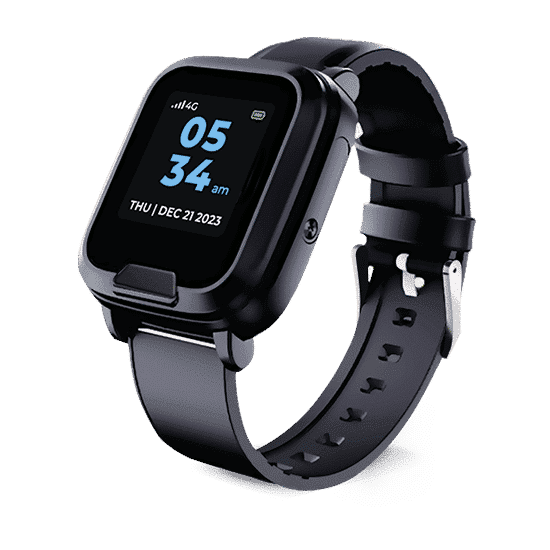
- Heart rate monitor, step counter, and optional fall detection
- Voice prompts for low battery status, device charging, and more
- Waterproof for shower and tub use
- Device type: GPS smartwatch
- Fall detection: Yes
- Max. battery life: 10 hours
- GPS tracking: Yes
- Caregiver alerts: Yes
- Connection type: LTE
What’s different about the Smartwatch
The Medical Alert Smartwatch combines the look and convenience of a smartwatch with the emergency response access and fall detection of a medical alert device. Like the rest of Medical Alert’s offerings, our testers said setup was quick and smooth. One liked how high-quality the equipment looked when they took everything out of the box. “I think the packaging and aesthetic is great—the watch and its accessories are laid out in an impressive way and it looks high-end,” the tester said.
Our testers thought the device was comfortable to wear, but notably larger than a traditional smartwatch. The watch face is a touchscreen with a physical help button on the bottom. We liked that a cancel option pops up on the screen when we pressed the button. This saves someone from having to speak with monitoring center staff if they accidentally pushed the button. In our February 2025 medical alert system survey, 20% of people who purchased a system said they were nervous about setting their alarm off on accident.3

The audio quality of the watch is good. I understood every word without straining,” said a tester.
If you’re an active person who wants the security of a medical alert device or someone who’d rather wear a device that looks less medical, the Medical Alert Smartwatch could be a good choice for you.
But watches aren’t as accurate at detecting falls as medical alert devices worn around your neck or on your belt.4 If you have a high falls risk, we recommend the Medical Alert Mobile System.
How much do Medical Alert devices cost?
Medical Alert devices cost anywhere from $27.95–$47.95 per month, depending on which model you choose. All of the devices come with a one-time $99.99 activation fee, except for the Smartwatch, which has a $159.99 activation fee. This is more expensive than some competitors, like MobileHelp, which doesn’t have any additional fees. For more information, see our MobileHelp review.
Medical Alert offers several additional features, including:
- Lockbox: $2.99 per month
- Protection plan: $1 per month
- Fall detection: $10 per month
Table 2 Comparing the cost of Medical Alert devices
| Home System | Mobile System | Smartwatch | |
| Monthly cost: | $27.95–$37.95, depending on connection type | $47.95 | $39.95 |
| Equipment fee | No | No | $159 |
| Fall detection | $10/mo | $10/mo | $10/mo |
How to save money on Medical Alert devices
The simplest way to save money on a Medical Alert device is to purchase an annual plan. You would receive a discount on the monthly subscription price, a free lockbox, and free shipping. For example, you’d pay $34.95 per month for the smartwatch instead of $39.95, or $5 less. Medical Alert also offers a semi-annual plan that includes free shipping.
Medicare and Medicaid usually don’t cover medical alert devices, but you might be able to use your health savings account or flexible spending account to pay for it. Some private insurances might also cover a device. Make sure to check your insurance coverage before purchasing a device.
Medical Alert accessories and options
Medical Alert offers several accessories and extra options:
- Lockbox: If you’re unable to reach the door when you need help, a lockbox grants access to emergency responders for you. It holds a key and is protected by a code that the response center staff will provide.
- Fall detection: Fall detection is technology that automatically senses when you’ve fallen. Your device will call for help automatically, even if you can’t push the button yourself.
- Protection plan: A protection plan covers loss, theft, and damage of your device so you don’t have to pay out-of-pocket for a new one.
- Medical Alert Connect: Medical Alert Connect is a mobile app that allows you to manage your account, check battery levels, and receive notifications.
The Medical Alert user experience
Our testers found Medical Alert’s devices to be user-friendly and simple to set up. They liked that the devices came in clearly labeled packages with visual cues in the instruction manual. “I had no issues with the initial setup and testing of the device,” said one tester. “I found all of it easy, including canceling the help signal.”
We liked how accessible the devices are, with clear print and big buttons. This is helpful for people who don’t want to spend a lot of time learning the ins and outs of a new technology.
After setup, our testers were impressed by the way the devices felt while wearing them. “It is comfortable, light, and doesn't bump or bounce a lot when I'm walking,” one tester said. And though the devices felt good to wear, most testers thought they looked bulky. An unattractive device is a leading reason why people don’t wear their systems. And the best device for you will be one that you want to wear every day. If the look of the medical alert system could be a problem for you or someone in your care, you may want to consider the smartwatch.
When we tested the help button, we thought the response center staff was friendly and professional. We liked that they introduced themselves with their name and established a positive connection first. The smartwatch has a cancel option in case you press the button on accident, but the home and mobile systems did not.
Medical Alert’s customer service and warranty
- Warranty and trial period: Medical Alert doesn’t offer a trial period. The company’s warranty covers manufacturer defects, and you can add a protection plan for $1 per month.
- Returns: You can cancel your subscription at any time by emailing CustomerRelations@medicalalert.com or calling 800-800-1003. Once you’ve canceled, you’ll need to mail back your equipment.
- Customer service: Visit Medical Alert’s customer service page to explore help guides or send a message. You can also email them at CustomerRelations@medicalalert.com or call 800-800-1003
Are Medical Alert devices right for you?
Medical Alert devices are good choices for people who want a device with simple, clear setup and straightforward features. Medical alert systems work best when they are worn consistently. If your device feels too complicated or overwhelming, you might be tempted to stick it in a drawer, where it does you no good. We think Medical Alert helps solve this problem by focusing on user-friendly features.
When we surveyed medical alert system users in February 2025, we learned that 75% of surveyed adults bought a medical alert device for themselves or a loved one after experiencing a fall. For many people, the time period after a fall is scary and stressful. It’s hard to be open to using a new device like a medical alert system when you’re recovering. But we think Medical Alert’s clear instructions and simple-to-use devices can help ease the transition.
“Medical alert systems are essential tools for promoting independence and safety, especially for older adults living at home or in communities,” said Moti Gamburd, CEO of Raya’s Paradise, an older adult care community in California. “These systems allow people to quickly call for help in case of an emergency, such as a fall, without having to struggle to reach a phone. This timely access to assistance can be lifesaving, especially for those living alone or with limited mobility.”
If someone you know could benefit from a medical alert system but is resistant, try using the tips in our article on how to talk to someone about a medical alert device.
Ask yourself these questions as you explore Medical Alert’s different options:
- What is your lifestyle like? Do you stay at home or leave the house?
- Do you mind the appearance of a medical alert device or want something discreet?
- Do you live somewhere with strong cellular coverage?
Frequently asked questions
How much does Medical Alert cost?
Medical Alert costs anywhere from $27.95–$47.95 per month. All of the devices come with a one-time $99.99 activation fee, except for the Smartwatch, which has a $159.99 activation fee.
How does Medical Alert work?
Medical Alert works by connecting the user to a 24/7/365 emergency response center when a help button is pushed or a fall is detected. The center then coordinates with emergency responders.
Does Medicare cover Medical Alert?
No, Medicare does not cover Medical Alert or any other medical alert devices.
Is Medical Alert worth it?
Yes, Medical Alert is worth it if you have a fall risk or might need sudden emergency help.
What network does Medical Alert use?
Medical Alert uses AT&T for its cellular, mobile, and smartwatch models.
Can there be multiple users for each Medical Alert system?
No, each system is designed for one user.
What is the return policy for Medical Alert?
You can cancel your account and mail back your equipment at any time.
Questions? Email us at reviewsteam@ncoa.org
